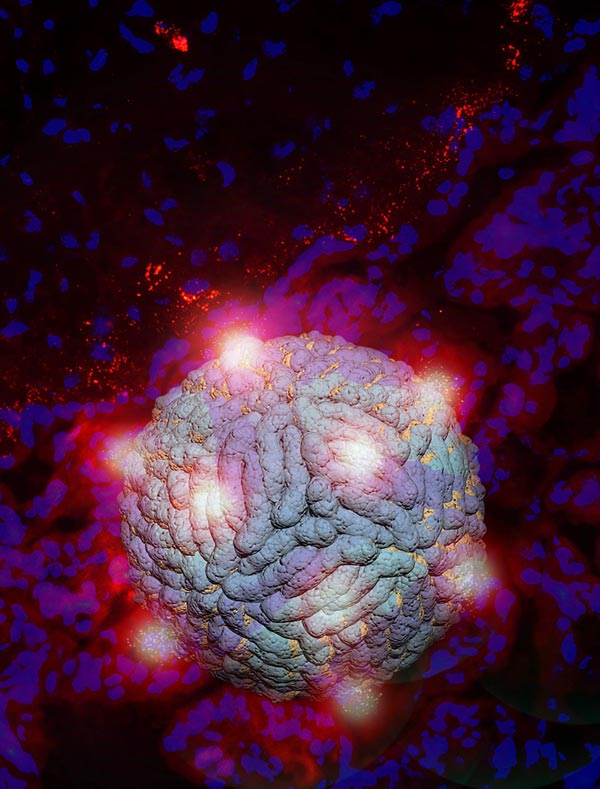Material from shellfish delivers a boost to bioassays and medical tests

An artistic rendering of a virus particle (light blue, foreground) bound by brightly-colored reporter molecules in a common laboratory assay. Credit: Junwei Li/Xiaohu Gao
More sensitive tests would allow scientists to identify pathogens, diseases and specific cellular proteins even when these “biomarkers” are present at levels far below the detection threshold of today's standard tests. Initial results show polydopamine boosted the accuracy and resolution of these tests for biomarkers of HIV, Zika virus and proteins on cancerous tumors.
“Common bioassays are the real workhorses of laboratory experiments and medical tests,” said Xiaohu Gao, a UW professor of bioengineering. “By boosting the sensitivity of these tests, we can enable more accurate medical diagnoses earlier in a disease or condition, and enable more certainty and less waste in the research process.”
Gao led the team that developed this simple modification for many common medical and laboratory assays. They recently published their approach — known as enzyme-accelerated signal enhancement, or EASE — in Nature Biomedical Engineering.
EASE centers on the simple addition of two biochemical components, dopamine and horseradish peroxidase, or HRP, at a key step. HRP is a common protein enzyme used to speed up the rate of reactions in biomedical research. Gao and his team discovered that HRP can connect dopamine molecules together to form the polymer chain polydopamine.
Polydopamine, in turn, accumulates on the surfaces of reaction vessels, such as small Petri dishes. Once the polydopamine is present, scientists can continue the traditional steps of their protocols, but now with a substantially increased test sensitivity. Gao hopes that this simple modification will mean that scientists and medical professionals can easily incorporate EASE into their common practices and procedures.
“Scientists have been trying to improve the accuracy of these common tests for decades, but solutions often involve entirely new protocols or costly pieces of equipment,” said Gao. “Understandably, researchers can be reluctant to invest in unfamiliar protocols or expensive new equipment — but EASE is a simple addition to tried-and-true assays. It's like a software upgrade, instead of changing your operating system.”
These assays include some of the most common medical and laboratory tests, such as ELISA, microarrays, FISH and immunohistochemistry imaging. Some of these assays have been used for decades to help hospitals and doctors detect signatures of a disease, ailment or other conditions by looking at a patient's blood, other body fluids or cells. Depending on the test, these telltale signs could be pieces of a bacteria or virus, a chemical, antibodies made by white blood cells, a hormone or even pieces of DNA.
But if these compounds are present at extremely low levels, diagnostic tests can miss them and return inaccurate medical information. By increasing sensitivity, EASE reduces uncertainty and even increases the amount of information these tests can provide. For example, the team used EASE to detect the presence of Zika virus in the placental tissues of primates. But EASE made the assay so sensitive that they were able to see which types of cells within the placenta were infected with Zika, Gao said.
As often happens in research, Gao and his team did not originally set out to solve this problem. Polydopamine was originally isolated from mussels decades ago, and researchers already knew that the substance can react with proteins. But the only protocol they had to form polydopamine necessitated a passive, time-consuming protocol. Lead author Junwei Li, a UW doctoral student in materials science and engineering, was using this approach to coat nanoparticles with polydopamine. But Li noticed that HRP can react with dopamine to form polydopamine, and that this approach is substantially faster than existing methods to make polydopamine.
The scientists don't fully understand why adding polydopamine boosts the sensitivity of these bioassays, and future research could elucidate the mechanism. But Gao's focus is on applying EASE to even more diagnostic tests and diseases.
“EASE has potential to solve real, long-standing problems in research and medical tests,” said Gao.
###
UW co-authors are pharmacology doctoral student Madison Baird; research scientists Michael Davis and Wanyi Tai; Larry Zweifel, associate professor of pharmacology and psychiatry and behavioral sciences; Kristina Adams Waldorf, professor of obstetrics and gynecology; Michael Gale, professor of immunology; and Lakshmi Rajagopal, associate professor of pediatrics. An additional co-author is Robert Pierce with the Fred Hutchinson Cancer Research Center. Adams Waldorf is also a faculty member with the Sahlgrenska Academy in Sweden, and Rajagopal is also associate professor at the Seattle Children's Research Institute. The research was funded by the National Institutes of Health, the University of Washington and the Howard Hughes Medical Institute.
For more information, contact Gao at xgao@uw.edu or 206-543-6562.
Grant numbers: R21CA192985, R01AI100989, AI083019, AI104002, AI060389.
Media Contact
All latest news from the category: Materials Sciences
Materials management deals with the research, development, manufacturing and processing of raw and industrial materials. Key aspects here are biological and medical issues, which play an increasingly important role in this field.
innovations-report offers in-depth articles related to the development and application of materials and the structure and properties of new materials.
Newest articles

A ‘language’ for ML models to predict nanopore properties
A large number of 2D materials like graphene can have nanopores – small holes formed by missing atoms through which foreign substances can pass. The properties of these nanopores dictate many…

Clinically validated, wearable ultrasound patch
… for continuous blood pressure monitoring. A team of researchers at the University of California San Diego has developed a new and improved wearable ultrasound patch for continuous and noninvasive…

A new puzzle piece for string theory research
Dr. Ksenia Fedosova from the Cluster of Excellence Mathematics Münster, along with an international research team, has proven a conjecture in string theory that physicists had proposed regarding certain equations….



